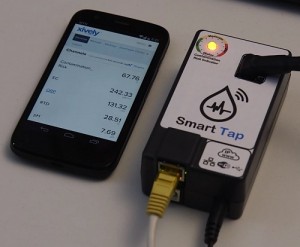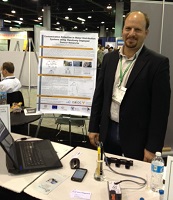 Smart Tap:
Smart Tap:
Real Time Monitoring and Assessment of Potable Water Quality at Consumer Sites
Contestant: Dr. Theofanis Lambrou
Semi-Finalist
Contact Information: faniseng@gmail.com
Smart Tap Demonstration
Read More: IEEE Explore
Summary
Smart Tap is an IP-enabled device for real time monitoring of potable water contamination at consumer sites. This device is a low cost, integrated hardware-software sensory system that allows in-pipe (or in-tank) monitoring of water quality. When contamination or significant violation in any key water quality parameter is detected, an alert is sent to interested parties/users. Alerts and pertinent data are transmitted over the Internet Protocol to a cloud service and can be received by smartphones, tablets, laptops etc. This system may be used equally efficiently by home-owners as by industrial users (hospitals, hotels, cruise ships, etc) and water utilities. The system can provide a pervasive early warning system for potable water quality through the Internet of Things.
How does Smart Tap use Internet Technology?
Smart Tap is an IoT (Internet of Things) device that can be installed at consumer premises (e.g. in the kitchen sink cupboard). This device collects water quality measurements from sensors, implements an algorithm that assesses water quality and transmits data and alerts to water consumers using the Internet Protocol (IP).
We choose to use IP for human interaction because:
a) It allows the SmartTap system to use existing home networking infrastructure to send information and alerts over the internet.
b) It provides the SmartTap system with multiple options to interact/notify water consumers without additional equipment, e.g. using Smartphones, Tablets, Laptops, Smart TVs, etc.
c) It enables the system to transmit data and alerts about water quality to multiple users simultaneously, as well as not needing to be within communication range of the device to receive this information.
d) It allows the system to use established/stable software and tools to interact with humans without frustration.
The Minimum Viable Product (MVP) will be comprised of the Smart Tap sensory system and a Smartphone application that provides the clients (consumers) with information, notifications and alerts about their water quality through the internet (via a cloud service). Smart Tap is currently uploading data to Xively Cloud Service using the RESTful api.
The IPv6/6LoWPAN protocols also enable advanced networking capabilities for our future developments, such as machine-to-machine interaction (between topologically neighboring SmartTap nodes in large scale deployments, e.g. the city water distribution network) as well as human interaction (receiving consumer complaints about water taste, smell, etc.). This will enhance the water quality data and provide more reliable alerts to water utilities and authorities.
Why did you choose to invent Smart Tap? What problem do you see that it can solve?
Providing clean drinking water to the population has become increasingly challenging with the depletion of water resources and the pollution of water bodies around the globe. Smart Tap provides a pervasive early warning system for drinking water quality.
Several scientific studies have indicated the need for continuous on-line water quality monitoring with efficient spatiotemporal resolution. They have demonstrated that conventional practices (i.e manual sampling with laboratory analysis or using expensive and bulky instruments to monitor quality at a few central locations) fail to monitor the entire distribution system and thus the quality of the water delivered to consumers. Hence, the challenge was to develop a reliable and low-cost sensing system with algorithms for pervasive, consumer-centered and continuous in-pipe water quality monitoring.


Rapid detection (and response) to instances of accidental or deliberate contamination is critical due to the potentially severe consequences to human health. Existing monitoring methods are too slow to provide public health protection in real time. Breaches in physical and hydraulic integrity of a water distribution system can lead to the influx of contamination across pipe walls, through breaks, and via cross connections. Drinking water can serve as a transmission vehicle for a variety of hazardous (biological, chemical, etc) agents, which can produce adverse effects in humans through multiple routes of exposure (ingestion, inhalation and dermal contact). Water contamination events can have a dramatic effect on everyday life, as well as on the local economy. In 2014, some of the large-scale contamination events included the chemical contamination in West Virginia (USA), which affected 300,000 people, and the crude oil infiltration in the water system of Lanzhou (China), which affected 2.4 million consumers.
Recently, the US Environmental Protection Agency (EPA) has carried out an extensive experimental evaluation of water quality sensors to assess their performance on several contamination sites. The main conclusion was that many of the chemical and biological contaminants used have an effect on many of the water parameters monitored, including Turbidity (TU), Oxidation Reduction Potential (ORP), Electrical Conductivity (EC) and pH. Thus, it is feasible to monitor and infer information about the water quality by detecting changes in such parameters.

The Smart Tap system is comprised of the aforementioned electrochemical and optical sensors and is designed to be low cost and lightweight. Such implementation is suitable for large deployments enabling an Internet of Things platform (sensor network) for providing spatiotemporally rich data to water consumers and authorities.
What is the practical application of Smart Tap for the everyday user?
Smart Tap is a smart consumer device for real time monitoring and assessment of drinking water quality at consumer sites. The system can be installed in your home and silently monitors the health of your water supply while transmitting notifications and sensory data to users via IP. The device implements an intelligent algorithm that fuses multi-sensor measurements in order to assess a water contamination risk. Significant water quality violations or aberrations are detected and quantified by a contamination risk indicator (expressed as a percentage). The system can be used by home-owners as well as by industrial users (hospitals, hotels, cruise ships, etc.).
A network of Smart-Tap systems can also be used as a cyber-physical system for monitoring the water quality in the drinking water distribution system from the source to the tap. This cyber-physical system of Smart Taps can provide a contamination alert service for water utilities. This network will provide data to a cloud service, where water utilities could access information about the drinking water quality at several places or events and execute algorithms to localize contaminations occurring in the drinking water distribution network. Water utilities will save money, time, effort, and protect consumers’ health.
Are there plans to produce Smart Tap for the marketplace, or is it already a product that can be purchased/obtained?
The Smart Tap IoT device is in an advanced development phase (TRL 6) but is not yet available on the marketplace. We are currently under the third-stable revision of the hardware platform (analog signal conditioning boards), and hardware, firmware and algorithms already have been evaluated and validated under a laboratory environment.
In addition, the system is currently being tested in field installations (water utilities main supply pipes) in Nicosia, Cyprus.
Why would you consider Smart Tap to be “innovative”?
Smart Tap is innovative because it proposes the idea of monitoring the quality of water delivered to consumers, using a low cost IoT sensory device. This idea is original, new, and important for the health and well-being of all humans. To the best of our knowledge, there isn’t another IoT consumer device worldwide that is able to sense water quality, process/fuse multi-parametric sensor responses and communicate its decisions about the risk of water consumption through the internet.
In addition, Smart Tap emphasizes the need for a shift in the current water monitoring paradigm and proposes an IoT device for monitoring the quality of water delivered to consumers, using low-cost, low-power and tiny sensors. We argue that this approach can achieve more reliable quality monitoring due to the large, spatially distributed deployment and the possibility of correlating quality measurements between sensors. In the future, Smart Tap can use the IPv6/6LoWPAN protocols to enhance the water quality information through data provided by topologically neighboring SmartTap nodes or data provided by neighboring water consumers (complaints about water taste, smell, etc.).
What would you like to see in the future for the Internet of Things? Why should more companies utilize IP?
The Internet of Things (IoT) is the network of physical objects accessed through the Internet. IoT will change the way we perceive and interact with the world around us. It will enable our living environment (home, cars, offices, critical infrastructures, etc.) to be more pro-active and have an adequate level of intelligence. Currently, IoT devices/ Smart Objects are considered complicated equipment for early gadget adopters. However, this is changing rapidly as more user friendly hardware and software platforms are becoming available; the Android Smartphone is an excellent example.
In the future, we would like to see the Internet of Things be comprised of Smart Objects that integrate more sensing, computation, communication and actuation capabilities that cooperate to perform higher-level operations and complex goals in dynamic and uncertain environments. Such Smart Objects must perceive, reason and act based on the data that is acquired and should be self-adaptive, robust, safe, intuitive and affordable.
Companies should utilize IP because it enables Smart Devices/Objects to use existing networking infrastructure for receiving/sending information over the internet. Moreover, users can easily interact with Smart Devices/Objects without additional equipment, e.g. using Smartphones, Tablets, Laptops, Smart TVs, etc. Finally, IP allows Smart Devices/Objects to use established /stable software and tools to interact with humans without frustration. IP offers scalable, robust and secure communication and provides a common framework for developers.

